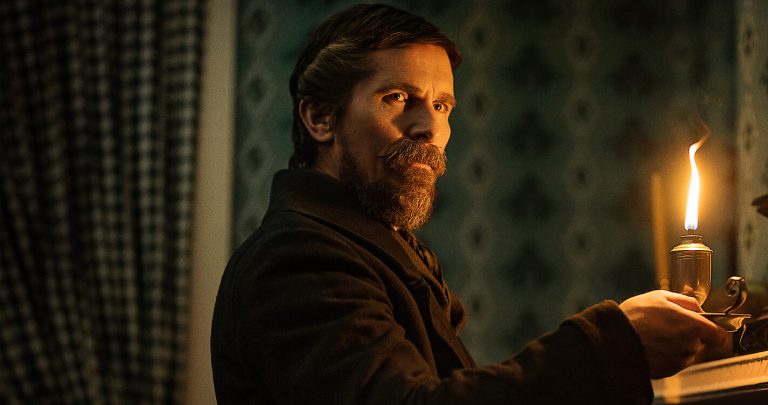Home and Ahead (2023) Review: Anirban Dutta’s Home and Ahead provokes the viewer’s curiosity immediately–this thoroughly experimental short feature begins with a cosmic allusion. A young girl sits on a chair on a rooftop, staring into the distance as masked figures revolve around her. These figures wear strange masks you would see in Halloween stores, carrying paper mache planets while traipsing around the lone chair. The group appears to form a makeshift solar system in miniature, with the figures as planets and the woman as the sun. Backgrounding this ritualistic orbit is the opening passage of Dinah Shore’s You’d Be So Nice to Come Home To, whose heavy strings and aching melody can only bring to mind tragedy.
As the sequence ends and the opening credits roll, we find that the woman (played by actress Satakshi Nandy) represents some concept of “Home.” That is, at least, what she is credited for, and this declaration in the first few minutes of the film prepares the viewer for a decidedly avant-garde experience. Home and Ahead is steeped in allegory and does not carry much in the way of plot or story. Dutta attempts to craft an analogical piece that suggests and implies more than it states or decrees, and while his direction does not quite achieve the scope of his vision, the ideas are certainly there.
Most of the film comprises scenes of Nandy, wearing a sleeveless dress and a dreamy expression, gliding through the halls of an abandoned manor. Occasionally, her character stops to arch over railings and appreciate views of the world outside. That world is the city of Calcutta, to whose spirit and people this film is literally dedicated. The place has no interest in being the home it once represented–cars and people go about their business, contributing by way of some of the film’s more well-composed and visually appealing visuals (including a shot of a fish market that caught my breath even though it was only a few seconds long).
That is not to say the cinematography of the manor is entirely devoid of exciting imagery. Dutta, who serves as–a deep breath–director, production designer, art director, sound designer, editor, colorist, writer, and cinematographer for the piece, captures some sophisticated compositions of Nandy as she strolls through empty halls. There is some excellent use of mirrors, and the film’s setting lends it an incredible amount of mystique. The imagery, both literal and thematic, keeps the viewer engaged through the slow pace and occasionally repetitive rhythms of the project (there are only so many times we can see a single actress stare at her surroundings).
Indeed, even at around thirty-five minutes, Home and Ahead has the capacity to wear on your patience. While it is clear that there were not a lot of resources put into the project (which is a reality for which we cannot blame the filmmakers), the craft does not display much maturity or deftness. Dutta’s style of cutting the picture frequently resorts to sudden fades-to-black and cheap flourishes like digital blurs and framerate tinkering. The film’s title screen contains, inexplicably, a glitched-out font of the kind you can find a hundred Photoshop tutorials for on YouTube. It comes right after the film zips past the thematically relevant quotations (I had to pause the screen to read them), while Dutta takes ages to cut in other places. Such elements prevent the picture from assembling a cohesive aesthetic.
The film’s soundtrack relies heavily on the performance of classical Indian crooning, and the intonations drown out everything else in the film’s soundscape. This is a shame since there is some great foley work here, particularly when we hear the sounds of the outside world from inside the house. Those moments (which include the sounds of traffic, rain, calls to prayer, and children’s laughter) give the viewer a sense of the displacement the central figure of the piece goes through. Alas, we barely hear them thanks to the overwhelmingly heavy hand that Dutta places on the music dial–in an attempt to make the viewer feel something, he robs them of the subtle pleasures of the best of arthouse cinema.
And the idea at the core of Home and Ahead is undoubtedly a subtle one. It becomes clear that Nandy plays the spirit of the home that Calcutta represents to Dutta. Belonging, identity, and livelihood are all concepts that tie into the film’s images, and the masked figures represent, to me, the ungrateful community that has forsaken these values. This is to the point that the home herself appears to fear these figures that once revered her. The ultimate conclusion of the project is quite hopeful, which is appreciable. However, one is left feeling that Dutta leaves far too much off-screen for the project to make a lasting impact.
Take, for example, the inclusion of the azan at a late point in the film. It is implied that the sound of the call to prayer is meant as a symbol of a more profound disharmony in communities, but because the film is content to stay within the confines of the manor house, it is unable to make this point land. Nandy’s performance similarly stays on a single track, rarely deviating from the status quo. And the less said of the quotation that ends the film, the better–it appears to put a stamp of meaning onto the film that defeats the purpose of embarking on such an open-ended project in the first place. If Dutta had the confidence to let his ideas grow on their own, things might have gone differently.


![In My Father’s Den [2004] – A Haunted Loner’s Journey through Time and Memory](https://79468c92.delivery.rocketcdn.me/wp-content/uploads/2016/06/In-My-Fathers-Den-1-768x431.jpg)

![Paterson [2016]: Silent Wonders of Life](https://79468c92.delivery.rocketcdn.me/wp-content/uploads/2017/05/1af9d050-85d0-11e6-b270-edf4b16cae3d_20160929_Paterson_Trailer1-768x432.jpg)
![The Insider [1999]: Tobacco & Truth Kill](https://79468c92.delivery.rocketcdn.me/wp-content/uploads/2016/04/The-Insider-768x432.jpg)

![The Middle Man [2021]: ‘TIFF’ Review – Coen-esque black comedy falls short of its potential](https://79468c92.delivery.rocketcdn.me/wp-content/uploads/2021/09/The-Middle-Man-1-highonfilms-768x322.jpg)